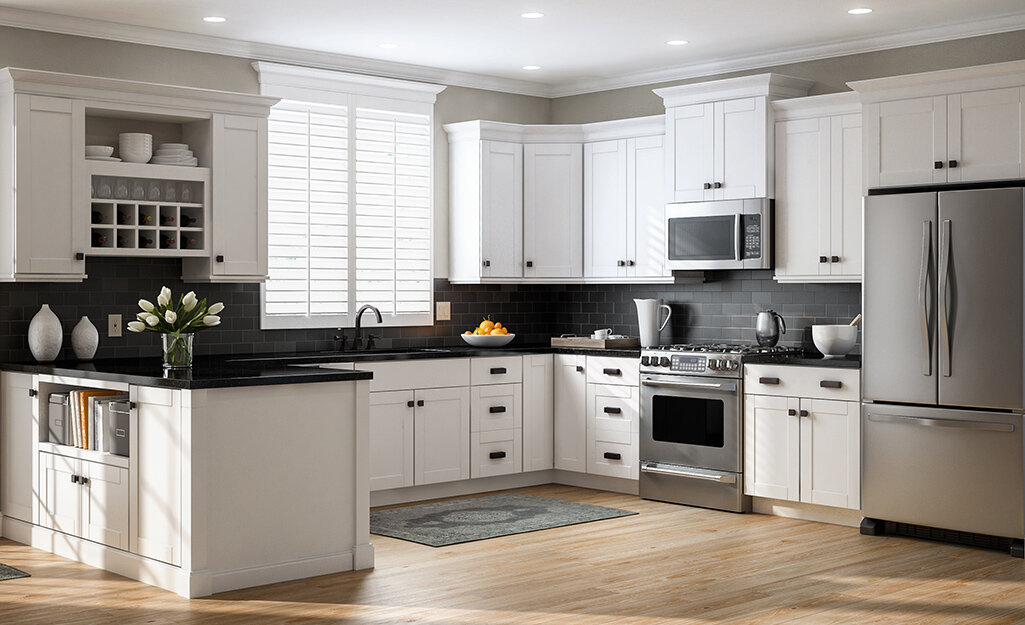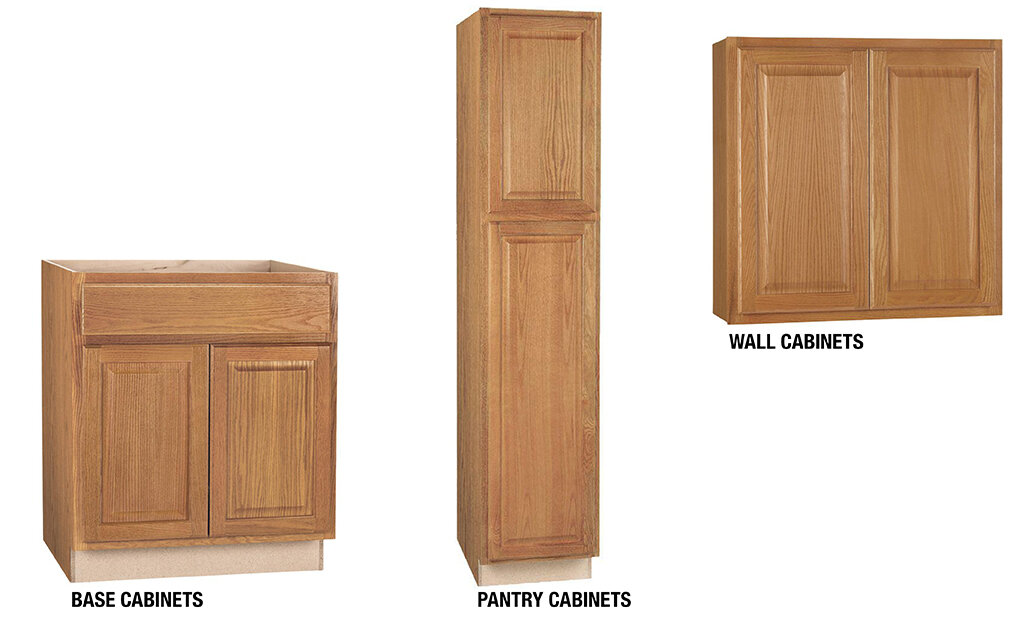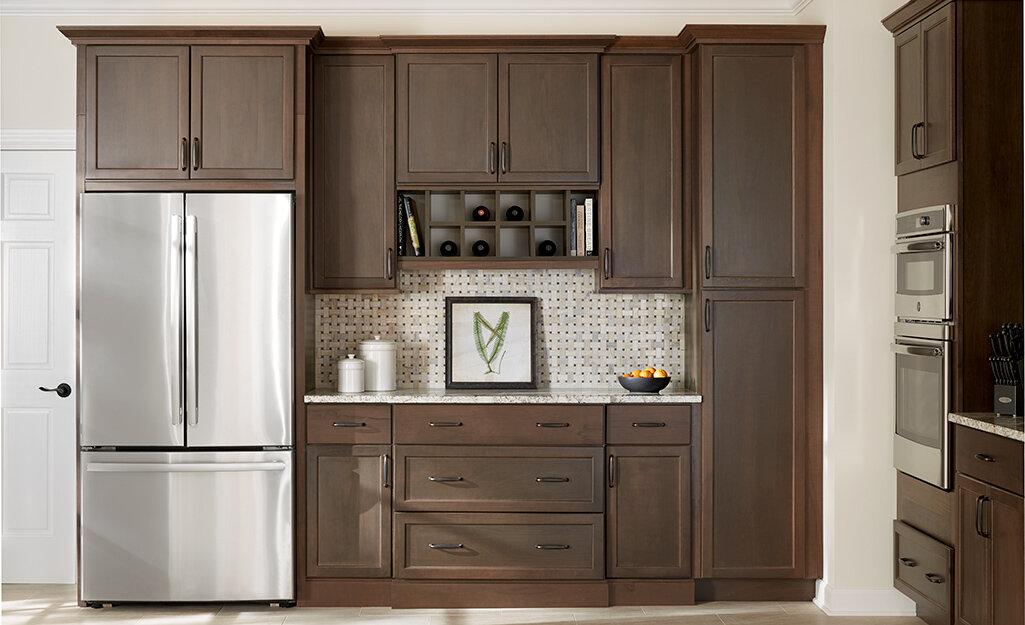Choosing Kitchen Cabinets
Best Kitchen Cabinets for Your Home
Updating your kitchen cabinets can completely transform the look, feel and efficiency of the space. This guide will teach you about cabinet materials, construction, designs and styles so you can find the best kitchen cabinets to create your dream kitchen.
Choosing Kitchen Cabinets
You can buy stock, semi-stock or custom kitchen cabinetry. Choosing which types of kitchen cabinets work best for you depends on your available kitchen space and budget.
Available in 3-inch width increments ranging from 12- to 60-inches wide.
Standard height: 30- to 36-inches.
Above-stove height: 12- to 18-inches.
Assembled kitchen cabinets available same day of purchase.
Ready to assemble cabinets available for DIYers.
Economical pricing.
Wider selection of wood and finish choices and a range of storage options.
Enhancements: pull-out shelves, lazy Susans, dividers.
Same available sizes as stock cabinets.
Requires several days for delivery.
Mid-range prices.
Handmade to fit your specific kitchen.
Ideal for irregularly shaped spaces.
Delivery time: nine or more weeks.
Can be built in increments up to 1/32-inches.
Most expensive option.
Types of Cabinets
Kitchen cabinets come in three configurations. Base cabinets support countertops, wall cabinets hang above counters or stoves and pantry cabinets fit in narrow spaces. The configuration typically determines the height of kitchen cabinets and the depth of kitchen cabinets. Below we list the standard size for kitchen cabinets of each type.
Rest on floor to support countertop.
Typically, between 34 1/2- to 36-inches tall and 24- to 30- inches deep.
Can be specialized to include sink or corners.
Tall cabinets ideal for narrow spaces.
Considered a type of utility cabinet and can be used in kitchens, pantry rooms or laundry rooms.
84- to 94-inches tall; standard depth of 12- to 18-inches.
Hang on wall.
Standard kitchen cabinet heights include 12-, 15-, 18-, 30-, 36- and 42-inches tall; depth ranges from 12- to 18-inches.
Typically installed 18-inches above countertops, 54-inches above floor and 24-inches above stove.
Kitchen Cabinet Materials
Solid wood kitchen cabinets are long-lasting, strong, attractive and often the most expensive. Relatively lower-cost engineered wood products like plywood, particleboard and MDF are also used to construct quality cabinets. Any of these materials can be used to make styles and types of kitchen cabinets that suit your kitchen.
Solid wood
Known for durability, quality and attractiveness.
Cabinet doors and face frames are often made from solid wood.
Popular choices are hardwoods like red oak and white oak or softwoods like spruce and fir. Hickory, maple or beech will resist scratching and denting but are more expensive.
Particleboard
Made of wood chips or shavings bonded together with resin and compressed into rigid sheets.
An affordable alternative to solid wood, particleboard is very stable.
Often used in stock cabinets as an underlayment for plastic laminates and wood veneers in the panels for the box and shelving.
Doesn’t warp, shrink or swell due to humidity, but should be properly sealed to protect against moisture.
Particleboard is assembled using glue or mechanical fasteners.
Medium density fiberboard (MDF)
Made from fine wood particles and glue formed into sheets.
Often used as a backing material for laminates and other finishes.
Very dense, resists warping and has a smooth surface suitable for veneers, laminates and paints.
Often used in mid-priced cabinetry.
Made of layers of veneers stacked and glued together. Alternate layers are oriented at right angles to each other, providing strength in length and width.
Furniture-grade plywood is used in custom cabinetry.
Because heat and moisture cause wood to expand and contract in the direction of the grain, plywood’s cross-grain pattern makes it stronger and more stable than solid wood.
Plywood is often used for cabinet boxes and shelves in higher-priced cabinetry.
Wood Veneers and Laminates
Opting for cabinet-grade plywood, particleboard/MDF covered with wood veneers, durable laminates or other synthetic materials will keep costs down without sacrificing style.
Wood veneers
Warmth and beauty of solid wood.
Affordable and versatile.
Consistent grain pattern.
Laminates
Durable and low maintenance.
Variety of colors and patterns.
Resists stains, warping, chipping and fading.
Melamine
High-quality options available.
Available with faux wood grains, bamboo and other textures.
Framed vs. Frameless Cabinets
Whether you choose framed or frameless cabinets depends on how you want your kitchen to look. Both framed and frameless cabinets come in a variety of beautiful styles and surfaces.
Framed cabinets or face frame cabinets
Have a frame on the front of the cabinet that makes the box highly stable and helps keep it square.
Door hinges attach to the frame.
Have a traditional feel.
Also known as European-style cabinets.
Have no frame around the face of the cabinet box.
Thicker side panels lend stability.
Because drawers do not have to fit in a frame’s opening, they can be as wide as the cabinet, providing more storage.
Have a modern feel.
Kitchen Cabinet Door Overlays
The overlay is the way the door rests on the face of the cabinet. Standard or traditional overlays are the most common type used in cabinet installation. Full overlays are when there is virtually no cabinet frame showing around doors or drawer fronts.
Standard overlay
Leaves the face of the cabinet box visible around doors and drawers.
Creates a visible frame called the “reveal.”
Reveals range from 1/2-inch to 1-inch around doors and drawers.
Full overlay
Doors may be separated by as little as 1/8-inch.
Most often used in contemporary design installations.
Usually more expensive because more material is used in their construction.
Tip: All frameless cabinets use full overlays, but full overlays can be used on framed cabinets as well.
Kitchen Cabinet Door Designs
Kitchen cabinet doors come in many different standard and custom designs. Among the most popular door designs are recessed panel, raised panel, Shaker, slab, and beadboard.
Doors have a flat center panel surrounded by a slightly higher rim or overlay.
Minimal style that adds depth and interest.
Work equally well with farmhouse or modern designs.
Doors have a raised center panel surrounded by a decoratively carved rim or overlay.
Look as though it was carved out of a single piece of wood.
Classic, timeless style.
Blend well with formal, traditional decor.
Have a type of recessed panel door with a simple, uncarved rim.
Iconic simplicity and a warm feel.
Have an understated look that suits many styles of kitchens.
Have a flat panel door that has no rim or overlay.
Considered neither recessed nor raised.
Create a clean canvas for cabinet pulls and hardware.
Streamlined look for contemporary kitchens.
Doors are a type of recessed panel that has a beadboard center panel. Beadboard describes vertical rows of narrow wood planks lined up together. Each plank is a “bead.”
Casual, classic cottage style.
A beautiful addition to informal, rustic or coastal kitchens.






